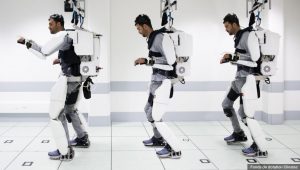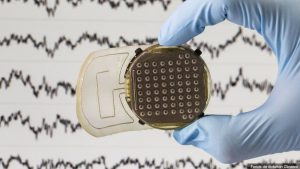At the meeting I attended in Japan, there was an exciting talk about exoskeletons and how research is enabling paralysed patients to control exoskeleton bodysuits with their mind.
Exoskeleton, by definition, is a “skeleton outside of the body”. Human exoskeletons are motorised external frames or ‘bodysuits’ that can be worn to support a person who has been injured or paralysed. The exoskeleton was first developed by General Electric in the 1960s and was a hydraulic and motorised bodysuit called ‘Hardiman’. However is was incredibly bulky and too heavy for everyday human use. Since then many companies have been trying to develop a more light-weight, intuitive and affordable exoskeleton that can be simply used by paralysed patients.
Exoskeletons are being developed not only to help patients who can not stand up and walk but also for those patients who cannot use their arms. So far helping patients to walk has been easier than allowing them to use their arms, hands and fingers for fine motor movements. Furthermore, until now the bodysuits have been too big and expensive for normal everyday use but as technology develops the suits are getting more streamlined, intuitive and hopefully will become widely available in the future.
In France scientists have surgically placed two implants on the brain of a paralysed man, with each implants containing 64 electrodes which trace his brain activity. The brain waves are turned into mechanical instructions by a computer to control the exoskeleton. Essentially, when the patient thinks “walk” the brain waves associated with that message get sent to a nearby computer which then remotely instructs the body suit to move his legs forward. Another patient being tested in the US who is paralysed from the neck down, caused by a degenerative disease, has had similar brain implants. She has learnt to control a robotic arm to feed herself. Fine hand and finger movements have been more difficult to control but they are certainly making huge progress.
For paralysed patients this type of technology will significantly enhance their lives. Several years ago I had the privilege of meeting a man who had been paralysed in a traffic accident and he was one of the first British patients to trial an exoskeleton. He told me that one of the best things about the exoskeleton for him was standing up and talking to everyone at eye level again. He loved being able to walk around and, although actually wearing the exoskeleton is tiring, his sleep improved and he had significantly less muscle cramps in his legs which he got from being in the wheelchair all day.

Photos of the French paralysed patient controlling his walking with his own mind.
Below is an example of the implants he has in his brain allowing his thoughts to control the exoskeleton.


Exoskeletons are also being used by the military to enhance biological performance and capabilities by increasing their strength and endurance. The US army is investing millions of dollars developing military bodysuits that are extremely lightweight and worn over their normal clothes. Using sensors and artificial intelligence the bodysuits will help the soldiers natural movements and therefore enable them to run/walk faster and further than normal without getting tired. In other words they are trying to develop a ‘super-soldier’. The bodysuits being developed by the military are significantly less bulky than the one pictured above because they are only enhancing function not replacing it.


